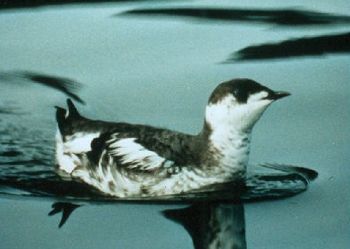
Publisher:
Bonnie King
CONTACT:
Newsroom@Salem-news.com
Advertising:
Adsales@Salem-news.com

~Truth~
~Justice~
~Peace~
TJP
Jan-21-2010 14:38

 TweetFollow @OregonNews
TweetFollow @OregonNews
American Bird Conservancy Hails Agency Decision to Continue ESA Protection for Marbled Murrelet
Salem-News.comMany Concerns Remain for Species Headed Towards Extinction
 Marbled Murrelet. Photo: USFWS |
(WASHINGTON D.C.) - The U.S. Fish and Wildlife Service (FWS) announced that the threatened Marbled Murrelet should remain listed under the Endangered Species Act.
“There is no question that the Fish and Wildlife Service made the right call,” said George Fenwick, President of American Bird Conservancy. “We appreciate the agency’s commitment to sound science as reflected by this listing decision. The Marbled Murrelet is a rapidly declining, fascinating species that is in urgent need of additional rather than less protection. Today’s decision marks a new beginning for the conservation of this long-overlooked species.”
The previous administration’s proposal to delist the bird and eliminate endangered species protections was based on the assertion, discredited by a U.S. Geological Survey (USGS) report, that the murrelet’s population in Washington, Oregon, and northern California is not distinct from other murrelet populations in British Columbia and Alaska. That determination means that the Marbled Murrelet population is dramatically declining and protections for the species need to remain in place.
The USGS report released in 2007[1], shows dramatic declines in numbers of the Marbled Murrelet and supports the continued listing of the species as a distinct population segment. The report showed that populations of the murrelet are plunging in Alaska and Canada, with an overall decline of approximately 70% over the last 25 years from more than one million birds to about 350,000 in 2007.
“The Marbled Murrelet is a species in serious trouble that should be listed range-wide and up-listed to Endangered in the Lower 48,” said Steve Holmer, Senior Policy Advisor for American Bird Conservancy. “The most recent status review of the murrelet concluded that if the current trend of a 4-7% annual decline continues, the species will be extinct in Washington, Oregon, and California outside of the Puget Sound area.”
A diminutive seabird that occurs from the Aleutian Islands and the southern coast of Alaska south to northern California, the Marbled Murrelet is unique in its family for building its nest in the tops of old-growth trees. At the north of its range it also nests on scree slopes. The species is ranked high on the U.S. WatchList, a list of birds of conservation concern developed by scientists from American Bird Conservancy and National Audubon Society.
The primary threat facing the Marbled Murrelet continues to be the loss of its old-growth forest nesting areas. According to the U.S. Forest Service, in total, approximately 2% of murrelet habitat on federal lands was lost between 1996 and 2006, and 12% was lost on non-federal lands primarily due to timber harvest. There is also concern about the rapid loss of murrelet habitat under FWS approved Habitat Conservation Plans. From 1992 - 2003 an estimated 226,000 acres of murrelet habitat were lost.
“All is not well for the Marbled Murrelet; American Bird Conservancy remains concerned about a pending proposal to remove Critical Habitat protection at the very time the species needs additional conservation help,” said Holmer. “There is particular concern about the proposed reduction of 62,700 acres of Critical Habitat in Oregon in areas currently occupied by murrelets. The proposal is not supported by sound science. The draft proposal also fails to include additional Critical Habitat designations for many essential areas such as non-federal lands and nearshore coastal areas that the science indicates are warranted and necessary for the survival of the species.”
FWS Listing Decision Release: fws.gov/news/NewsReleases/showNews.cfm?newsId=4CC8214B-E5F9-F846-50010400866A9F3B
[1] pubs.usgs.gov/of/2006/1387/
Articles for January 20, 2010 | Articles for January 21, 2010 | Articles for January 22, 2010
Salem-News.com:


Quick Links
DINING
Willamette UniversityGoudy Commons Cafe
Dine on the Queen
Willamette Queen Sternwheeler
MUST SEE SALEM
Oregon Capitol ToursCapitol History Gateway
Willamette River Ride
Willamette Queen Sternwheeler
Historic Home Tours:
Deepwood Museum
The Bush House
Gaiety Hollow Garden
AUCTIONS - APPRAISALS
Auction Masters & AppraisalsCONSTRUCTION SERVICES
Roofing and ContractingSheridan, Ore.
ONLINE SHOPPING
Special Occasion DressesAdvertise with Salem-News
Contact:AdSales@Salem-News.com


Terms of Service | Privacy Policy
All comments and messages are approved by people and self promotional links or unacceptable comments are denied.
Raziye February 24, 2013 7:33 pm (Pacific time)
“And yet biodiversity — the sum total of all linvig species — is what gives us air to breathe, water to drink and food to eat…”Biodiversity is not just the “sum of all linvig species . It includes genetic diversity, ecosystems, and the natural cycles and processes that support life such as oxygen production, air and water purification, and soil formation. Biodiversity must include the conditions that support life; otherwise, there would be no life. We humans just one of an estimated 30 million species are part of biodiversity. Biodiversity is our life support system. If we lose 25% of species, we lose 25% of our life support system; yet, we continue to refer to biodiversity loss as though it somehow does not affect us.As predicted, the economic crash has preceded the ecological crash, which, when it happens, cannot be bailed out by financial institutions and governments. A loss of natural capital can only be “financed” with natural capital. The world had better start to take this VERY seriously VERY immediately, or we’re toast.It has been estimated that the value of the natural services provided by biodiversity amounts to $33 trillion a year: a sum not all the world’s nations acting together could afford because the global GDP is only $18 trillion.
[Return to Top]©2025 Salem-News.com. All opinions expressed in this article are those of the author and do not necessarily reflect those of Salem-News.com.